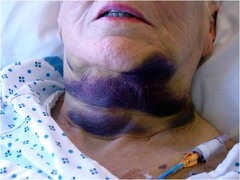Neck Injuries
Published .

Neck injuries may be open or closed. Open injuries to the neck will bleed profusely and easily cause death. Depending upon the patient’s position, airway passages may be obstructed due to significant bleeding to the neck. Medics should always consider the possibility of an underlying spinal injury when bleeding is found to the neck.
Neck injuries require consistent monitoring of the airway on scene and during transport. Patients with esophageal trauma may have difficulty swallowing, leading to airway obstruction. Swelling to the neck may be related to air escaping under the skin which can crackle with digital pressure (subcutaneous emphysema). All swelling to the neck should be palpated to ensure that the swelling is not subcutaneous emphysema. Laryngeal injuries will cause changes in voice sounds.
It is possible for air to enter the circulatory system if there is a penetrating injury to a large blood vessel in the neck. While it is easy for the medics to see the tremendous amount of bleeding that is surely coming from the patient’s neck, it may be more difficult for them to understand the possibility of air being sucked into the circulatory system. Changes in pressure associated with breathing are seen in the jugular veins. An open wound to a jugular vein (which has the tendency to fluctuate in venous pressure associated with breathing) can result in an air embolism. Bleeding wounds to the neck should always be immediately treated with an occlusive dressing. The first and best occlusive dressing for a neck injury is the medics gloved hand. After the bleeding is controlled, the medics may need to place an occlusive dressing over the neck wound to prevent any air from being sucked into the vascular system.
Laryngeal Trauma
Laryngotracheal injuries have a high mortality rate although they are infrequently seen. These injuries may be penetrating or blunt and can occur in the supraglottic, glottic, or infraglottic (below the glottis) regions. Accurate and prompt recognition of laryngeal injury is essential, and different patterns and severity of injury are seen in blunt versus penetrating laryngeal trauma. Any patient presenting with a history of anterior neck trauma must be thoroughly assessed for the presence of a laryngeal injury and a safe airway confirmed, or established emergently, before proceeding with further workup.
Motor vehicle accidents are the primary cause of laryngeal injury, though the frequency has been dramatically reduced with the advent of seatbelts, airbags, and other advances in automotive safety equipment. Other causes include penetrating trauma, assault, attempted strangulation, near hanging, and clothesline-type injuries. Iatrogenic (illness caused by medical examination) laryngeal injury can occur during bronchoscopy, emergent intubation, or percutaneous tracheostomy.
The larynx is typically protected from blunt trauma by the sternum and the mandible. Injury can occur when the neck is hyperextended due to trauma. It is usually evident by history or by primary trauma survey whether a patient has sustained a blunt versus penetrating neck trauma. The following mechanisms of injury most commonly result in laryngeal trauma:
- Rear-end automobile collision with a whiplash-type injury result in laryngeal trauma.
- ‘Clothesline’-type injuries where the exposed neck is impacted by a narrow-gauge object such as a tree branch or fence wire (often in the setting of motorcycle riding or snowmobiling).
- Larynx is intentionally targeted for damage during an assault (a direct strike to the neck to intentionally incapacitate the victim, or in strangulation).
Blunt Laryngeal Injury
The degree of severity often corresponds to the force applied as well as the area over which it is applied. High-velocity injuries can fracture laryngeal and/or tracheal cartilages and lead to structural deformities of the larynx and trachea. The most severe case is the “clothesline” injury, and the classic scenario is a motorbike or snowmobile rider who strikes a small, stationary object such as a fence wire or tree branch that impacts the anterior neck below the helmet line. This applies significant forces over a small area and can lead to severe crushing injury to the laryngeal (and/or tracheal) cartilage resulting in airway obstruction. This can also lead to laryngotracheal separation due to shearing forces. Less severe blunt laryngeal injuries can be sustained during sports or fisticuffs and may cause submucosal endolaryngeal injuries due to shearing forces that may not be immediately obvious on external examination, or may cause hyoid fractures. Airway obstruction can result immediately due to structural deformities, or can present later as post-injury edema increases and patients become symptomatic due to delayed airway obstruction.
Penetrating Laryngeal Injury

The severity will again depend on the mechanism. Lower-velocity penetrating injuries such as knife wounds may be minimally symptomatic initially, but post-injury edema or hematoma may lead to airway compromise. High-velocity injuries such as firearms injuries (particularly high-velocity hunting or military rifle rounds) are uniformly devastating, fragmenting and destroying tissues of the larynx and surrounding structures. A relative devascularization and scarring of these tissues can cause significant long-term stenosis, in addition to any immediate airway concerns due to tissue disruption or post-injury edema.
The initial history is paramount in evaluating potential laryngeal injury. Any patient with a history of anterior neck trauma warrants a high degree of suspicion for laryngeal injury. This includes the mechanism of injury (blunt versus penetrating), time since injury, and other associated injuries. It is especially important to remember the potential for laryngeal injury in the poly-trauma patient such as an automobile accident, as the patient may not be coherent or cooperative.
Symptoms worrisome for laryngeal injury:
- History of anterior neck trauma
- Hoarseness or voice change
- Pain in the anterior neck
- Dyspnea
- Dysphagia
- Subcutaneous emphysema
Physical examination begins with an overall assessment of the patient’s respiratory status. Stridor may be inspiratory, expiratory, or biphasic, depending on the level of injury, and may or may not be accompanied by voice changes. All patients with neck trauma must be ruled out for concomitant cervical spinal injuries. Examination of the neck should include palpation for tenderness over the thyroid cartilage and trachea, loss of normal thyroid cartilage prominence, subcutaneous emphysema, ecchymoses over the anterior neck, and assessment of the voice for hoarseness if possible. Penetrating injuries should be obvious at this point, but seemingly innocuous findings externally can mask severe internal laryngeal injuries – a thorough examination is warranted in all cases. If the patient’s airway is stable a flexible laryngoscopy should be performed to visualize the larynx and pharynx. If an obvious injury is identified, treatment should proceed
